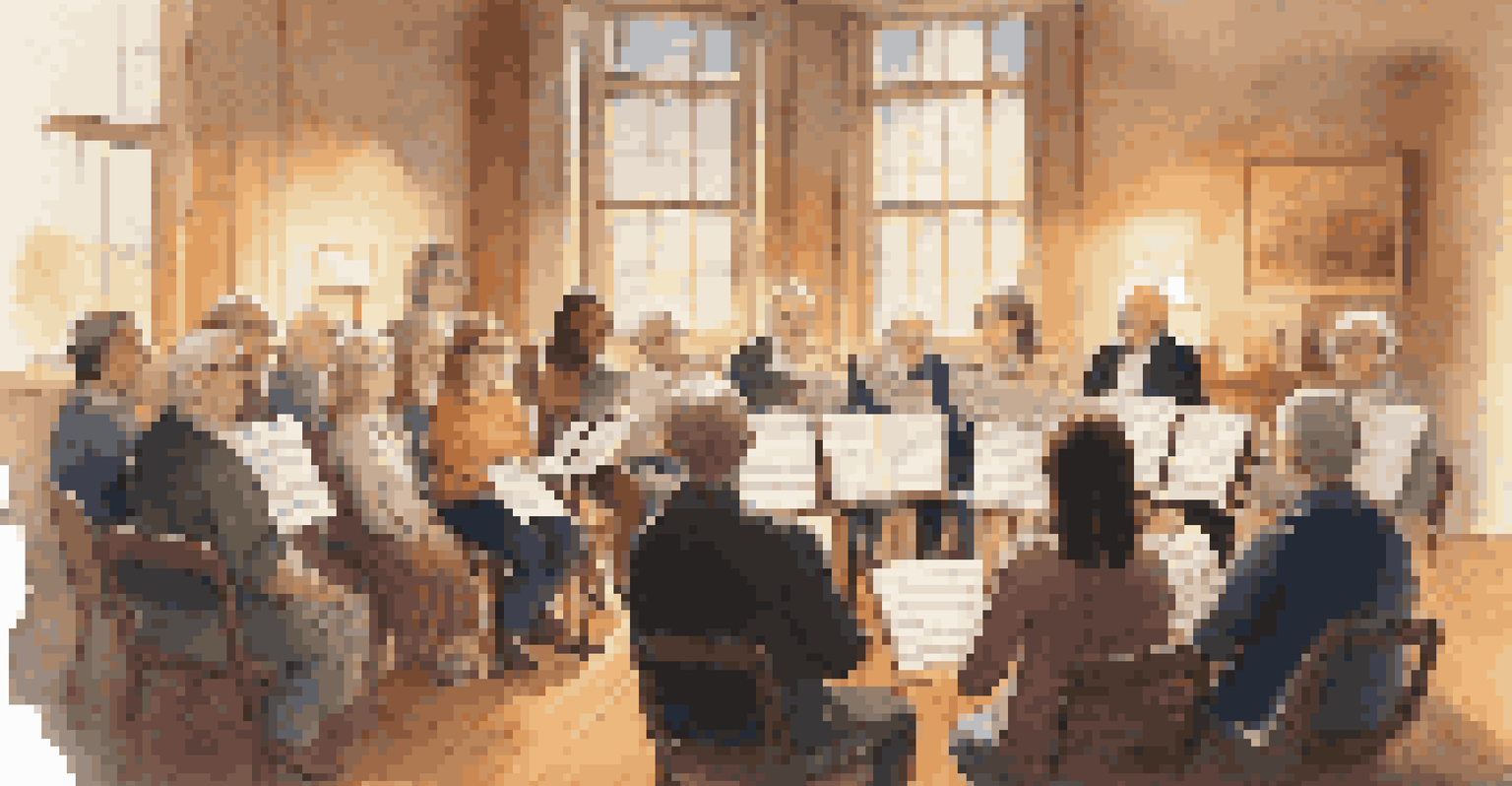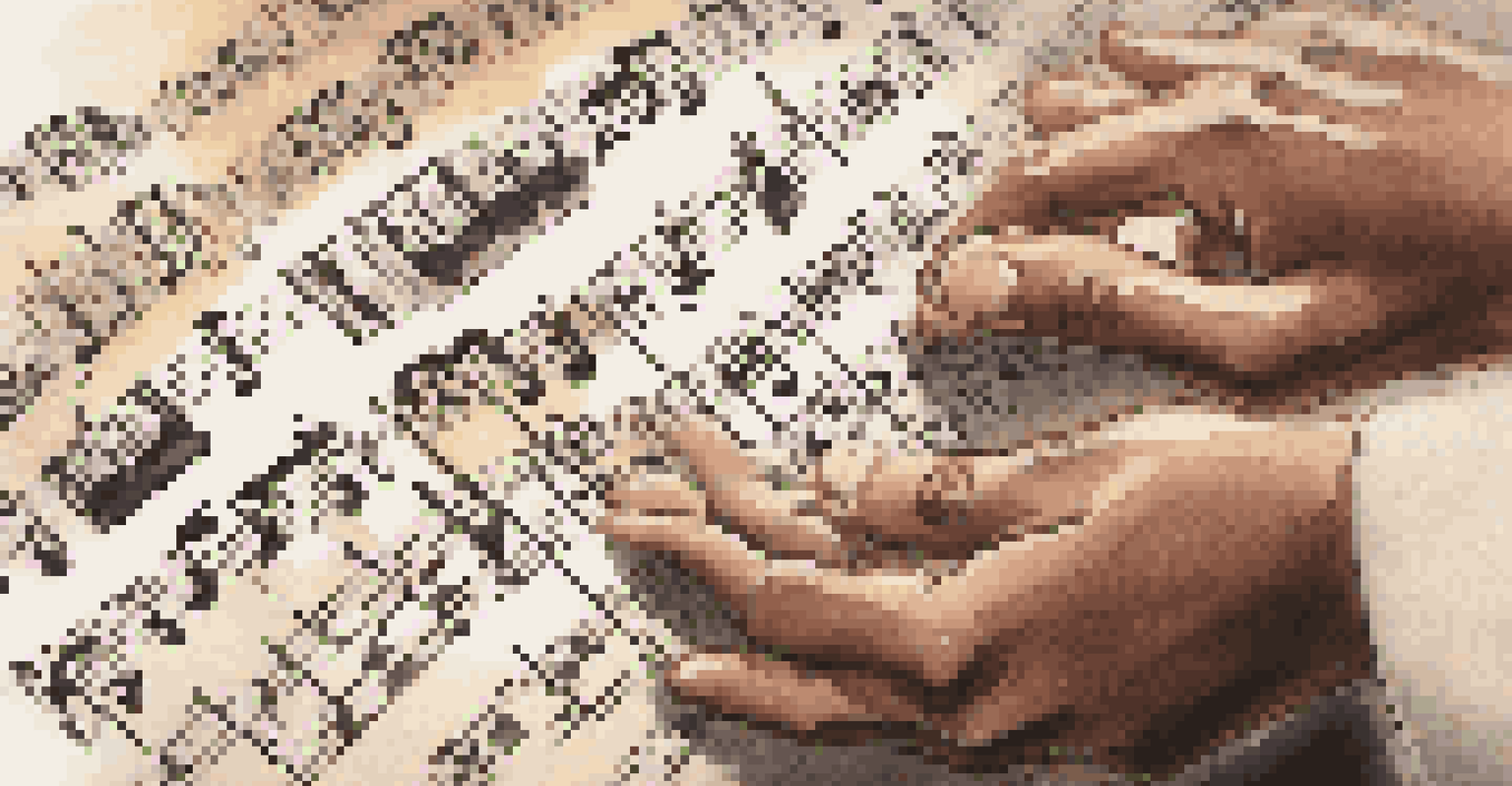Choral Music as a Reflection of Community and Cultural Values

The Historical Roots of Choral Music in Communities
Choral music has deep historical roots that often reflect the values of a community. It has been used in various cultures as a means of storytelling and preserving traditions, creating a shared sense of identity. For instance, in many Indigenous cultures, singing together has served as a way to pass down oral histories and connect generations.
Music can change the world because it can change people.
As societies evolved, so did the role of choral music, adapting to social changes while still holding onto its communal essence. In medieval Europe, for example, church choirs were central to religious life, uniting people in shared worship and reinforcing community bonds. This historical significance showcases how choral music acts as a lens through which we can view cultural evolution.
Today, choral music continues to play a vital role in community life, often seen in festivals, parades, and gatherings. It fosters a sense of belonging and encourages collaboration among diverse groups. This enduring legacy highlights how choral music not only reflects but also shapes the values of the communities it serves.
Choral Music as a Reflection of Cultural Identity
Choral music serves as a powerful expression of cultural identity, often embodying the unique characteristics of a community. Different regions boast distinct choral traditions, from the jubilant rhythms of African American spirituals to the intricate harmonies of Eastern European folk songs. These variations illustrate how music can encapsulate the essence of a culture.

For many communities, singing in their native language or style is a way to celebrate their heritage and assert their identity. This is evident in the growing number of multicultural choirs that blend diverse musical traditions, showcasing the beauty of cultural intersections. Such practices not only honor the past but also foster inclusivity in the present.
Choral Music Unites Communities
Choral music fosters teamwork and collaboration, bringing individuals together to create lasting bonds and strengthen community ties.
Moreover, choral music can be a tool for social commentary, reflecting the values and struggles of a community. Composers often draw inspiration from contemporary issues, creating works that resonate with listeners' experiences. This dynamic relationship between music and culture underscores the importance of choral music as a living testament to community identity.
The Role of Choral Music in Building Community Bonds
Choral music acts as a unifying force, bringing individuals together to create something greater than themselves. Participating in a choir fosters teamwork and collaboration, as members learn to harmonize their voices and work towards a common goal. This shared experience cultivates friendships and strengthens community ties.
Where words fail, music speaks.
Additionally, choirs often serve as a platform for outreach and social justice initiatives. Many community choirs engage in charitable performances that raise awareness and funds for local causes, showcasing the power of collective action. These efforts not only uplift individuals but also contribute to the overall well-being of the community.
The sense of belonging that arises from singing together is profound. Whether it’s through rehearsals, performances, or social gatherings, choir members often form lasting bonds that extend beyond the music. This fellowship is a testament to the ability of choral music to forge connections that enrich community life.
Choral Music and Social Change: A Powerful Catalyst
Throughout history, choral music has played a significant role in social change, often serving as a vehicle for activism. From the civil rights movement to recent social justice movements, choirs have harnessed the power of song to inspire and mobilize communities. This reflects the belief that music can be a powerful tool for expressing hopes and demands.
Songs that address social issues resonate deeply with audiences, allowing individuals to connect emotionally to the cause. For instance, the anthem 'We Shall Overcome' became synonymous with the fight for civil rights, uniting generations in a shared vision for equality. This illustrates how choral music can amplify voices and foster solidarity in the pursuit of change.
Cultural Identity Through Song
Different choral traditions reflect the unique characteristics of communities, celebrating heritage and fostering inclusivity.
Moreover, contemporary choirs often tackle pressing issues such as climate change and mental health awareness through their performances. By addressing these topics, they encourage dialogue and inspire action within their communities. In this way, choral music not only reflects cultural values but also actively shapes the future.
Choral Music and Generational Connections
Choral music serves as a bridge between generations, connecting young and old through shared musical experiences. Many choirs include members from various age groups, allowing for the exchange of ideas, traditions, and musical styles. This intergenerational collaboration enriches the choir's repertoire and fosters a sense of community.
In many cultures, older generations pass down songs and techniques to younger singers, ensuring that valuable traditions live on. This transmission of knowledge creates a rich tapestry of cultural heritage, where each generation contributes its unique voice. The result is a dynamic interplay that strengthens community identity over time.
Furthermore, choral music often evokes nostalgia and memories, linking individuals to their past. Whether it’s a familiar hymn sung in childhood or a song that marked a significant life event, these musical connections resonate deeply. This emotional bond highlights the importance of choral music in fostering relationships across time and space.
The Emotional Impact of Choral Music on Communities
Choral music has a profound emotional impact on both performers and listeners, often evoking feelings of joy, sorrow, and hope. The collective experience of singing together can create a sense of euphoria, lifting spirits and fostering a sense of unity. This emotional resonance is what draws people to participate in choirs and attend performances.
Research has shown that singing can boost mental health, reduce stress, and enhance overall well-being. For many, participating in a choir becomes a source of solace and support, especially during challenging times. This therapeutic aspect of choral music reinforces its role as a vital component of community well-being.
Music as a Catalyst for Change
Choral music has historically served as a powerful vehicle for social activism, inspiring communities to unite for justice and change.
Moreover, the shared emotional journey of rehearsing and performing can create lasting bonds among choir members. Celebrating achievements, mourning losses, and expressing collective emotions through music creates a sense of belonging that is invaluable. This powerful emotional connection underscores the importance of choral music in nurturing community spirit.
The Future of Choral Music in a Changing World
As we look to the future, choral music is poised to evolve alongside changing cultural landscapes. Technological advancements, such as virtual choirs and online performances, have expanded access to choral music, allowing people from diverse backgrounds to participate. This shift opens the door for new collaborations and innovative expressions of community values.
Additionally, the growing emphasis on diversity and inclusion in the arts will likely influence choral repertoire and practices. Many choirs are already embracing multicultural programming, showcasing a wide range of musical traditions that reflect their communities. This trend not only enriches the choral experience but also promotes understanding and appreciation among different cultures.

In conclusion, choral music will continue to be a vital reflection of community and cultural values. As communities face new challenges, the power of collective song will remain a source of strength and inspiration. The future of choral music holds great promise for fostering connections and uplifting voices in an ever-changing world.